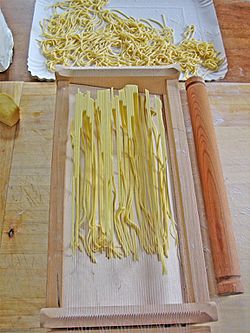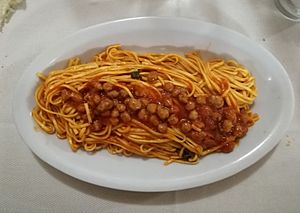Spaghetti alla chitarra facts for kids

Traditional preparation using chitarra
|
|
| Alternative names | Maccheroni alla chitarra |
|---|---|
| Type | Pasta |
| Place of origin | Italy |
| Region or state | Abruzzo |
| Main ingredients | Durum, egg, salt |
| Variations | Tonnarelli |
Spaghetti alla chitarra (also called maccheroni alla chitarra) is a special kind of egg pasta from the Abruzzo region in Italy. It looks like spaghetti but has a square shape, about 2 to 3 millimeters thick.
A similar pasta called tonnarelli comes from the Lazio region. There's also a thicker version of chitarra called ciriole, which is about twice as thick. Unlike regular spaghetti, which is pushed through a round hole, spaghetti alla chitarra is cut from a flat sheet of dough, which is why it's square.
Contents
What Does "Chitarra" Mean?
The name of this spaghetti comes from a special tool called a chitarra. This Italian word means "guitar." The tool looks like a wooden frame with many parallel wires stretched across it, just like guitar strings.
This "guitar" tool gives the pasta its unique square shape. It also makes the pasta a bit rough or "porous." This rough texture is great because it helps pasta sauces stick to the spaghetti better, making every bite delicious!
How This Pasta Is Made
The exact history of the chitarra tool isn't fully known. However, a traditional recipe from the Province of Teramo in Abruzzo might be from the early 1800s or even older. Some people also think the chitarra tool first came from the province of Chieti. Before this tool, pasta was cut using a special rolling pin with notches.
Even though spaghetti alla chitarra started in Abruzzo, you can find similar pastas with different names in other parts of southern Italy. For example, it's called tonnarelli in Lazio. In Basilicata and Apulia, it might be called torchioli, troccoli, or truoccoli. In Molise, it's known as cirioli Molisani.
Making the Dough
To make this pasta, you need durum wheat semolina and eggs. No salt is added to the dough. First, the ingredients are mixed and kneaded. Then, the dough rests for about 30 minutes, covered. After resting, it's rolled out very flat with a rolling pin.
Cutting the Pasta
Once the dough is flat, it's placed on the chitarra tool. The rolling pin is then used to push the dough through the wires. The wires act like sharp blades, cutting the dough into long, square strips. Pasta makers in Abruzzo often use their fingers to gently push the cut pasta down, almost like they are "playing a guitar" with the strings.
Serving Spaghetti alla Chitarra
In the Abruzzo region, maccheroni alla chitarra is often served with a rich meat sauce called a Ragù. This sauce usually has pork, beef, and lamb.
In some parts of Abruzzo, like Teramo, the traditional way to eat it is with a tomato sauce that has tiny beef meatballs. These small meatballs are called pallottine. This dish is known as chitarra alla teramana. It's usually served as a first course meal, which is called a primo piatto in Italy.
Sometimes, you can find a dried version of this pasta that doesn't have egg. It's sold as spaghetti or maccheroni alla chitarra both in Italy and other countries.
See also
 In Spanish: Spaghetti alla chitarra para niños
In Spanish: Spaghetti alla chitarra para niños


